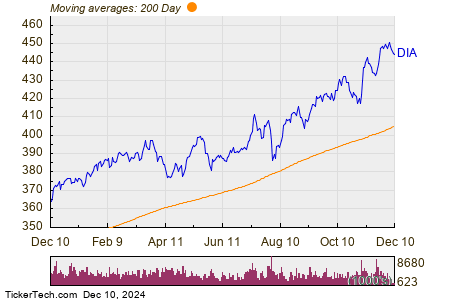SPDR Dow Jones ETF Sees Significant Inflow, Highlights Key Market Movements
SPDR Dow Jones Industrial Average ETF Trust Experiences Notable Changes
Today, a significant movement has been observed in the SPDR Dow Jones Industrial Average ETF Trust (Symbol: DIA). This ETF witnessed an inflow of approximately $511.8 million, which translates to a 1.3% increase in outstanding units week-over-week. The number of units rose from 86,942,867 to 88,092,867.
Among the ETF’s major holdings, UnitedHealth Group Inc (Symbol: UNH) is slightly up by about 0.1%, while Goldman Sachs Group Inc (Symbol: GS) decreased by approximately 0.5%. Caterpillar Inc. (Symbol: CAT) saw a larger drop of about 1.8%. To check the full list of DIA’s holdings, please visit the DIA Holdings page »
The following chart illustrates DIA’s price performance over the past year, alongside its 200-day moving average:

The one-year price range for DIA shows a low point of $363 per share and a high of $451.55. The latest trade came in at $444.60. Analyzing the most recent share price against the 200-day moving average can offer further insights into its performance. To learn more about this technique, check out information on the 200-day moving average »
Understanding ETF Trading Dynamics
Exchange-traded funds (ETFs) function similarly to stocks, but investors trade “units” instead of “shares.” These units can be traded like stocks, and they can also be created or destroyed based on investor demand. Each week, we monitor changes in shares outstanding to identify ETFs with significant inflows (where new units are created) or outflows (where existing units are liquidated). Creating new units requires buying the underlying holdings of the ETF, whereas destroying units means selling off those holdings. Thus, large flows can have considerable effects on the individual stocks contained within the ETFs.
![]() Click here to discover which 9 other ETFs had notable inflows »
Click here to discover which 9 other ETFs had notable inflows »
Also see:
- GDAY Videos
- WCC Options Chain
- JIVE Videos
The views and opinions expressed herein are those of the author and do not necessarily reflect the views of Nasdaq, Inc.

